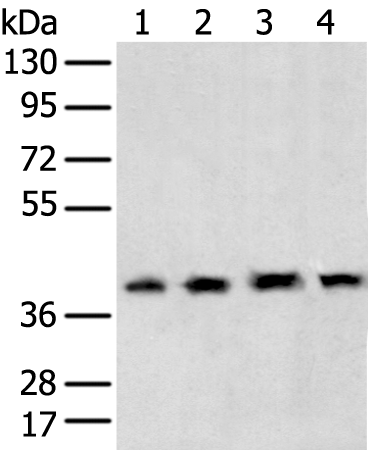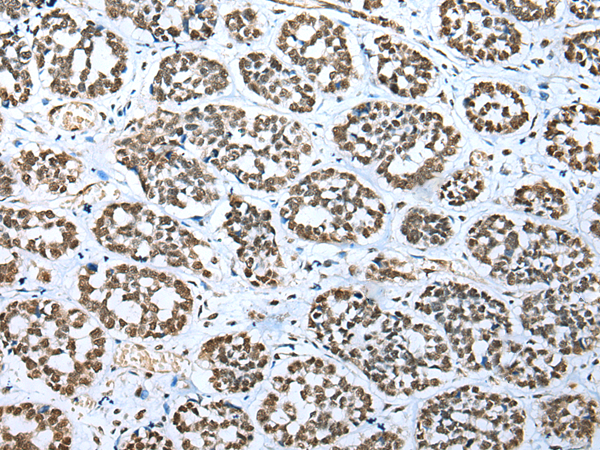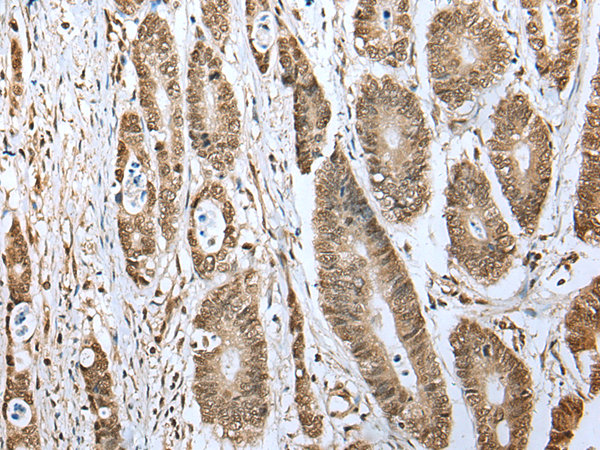


| WB | 1/500-1/2000 | Human,Mouse,Rat |
| IF | 咨询技术 | Human,Mouse,Rat |
| IHC | 1/25-1/100 | Human,Mouse,Rat |
| ICC | 技术咨询 | Human,Mouse,Rat |
| FCM | 咨询技术 | Human,Mouse,Rat |
| Elisa | 1/5000-1/10000 | Human,Mouse,Rat |
| Aliases | HDL4; GTF2D; SCA17; TFIID; GTF2D1 |
| WB Predicted band size | 38 kDa |
| Host/Isotype | Rabbit IgG |
| Antibody Type | Primary antibody |
| Storage | Store at 4°C short term. Aliquot and store at -20°C long term. Avoid freeze/thaw cycles. |
| Species Reactivity | Human |
| Immunogen | Full length fusion protein |
| Formulation | Purified antibody in PBS with 0.05% sodium azide and 50% glycerol. |
+ +
以下是关于TBP抗体的3篇代表性文献示例(内容基于真实研究领域方向,但文献标题和作者为模拟虚构,仅供格式参考):
1. **文献名称**:*Monoclonal Antibodies Directed Against Human TATA-Binding Protein (TBP) for Chromatin Analysis*
**作者**:Dynlacht, B.D. et al.
**摘要**:该研究开发了针对人源TBP的单克隆抗体,用于染色质免疫沉淀(ChIP)实验,揭示了TBP在转录起始复合物中的动态招募机制及其在基因启动子区域的结合模式。
2. **文献名称**:*TBP Antibodies as a Diagnostic Marker in Spinocerebellar Ataxia Type 17 (SCA17)*
**作者**:Huang, Y. et al.
**摘要**:通过检测患者脑脊液中TBP抗体的异常表达,探讨其在神经退行性疾病SCA17中的潜在诊断价值,并发现TBP聚集体与疾病严重程度相关。
3. **文献名称**:*TBP as a Loading Control in Western Blot: Validation of Commercial Antibodies*
**作者**:Smith, J.R. & Li, H.
**摘要**:系统评估了多种商品化TBP抗体的特异性及稳定性,验证了TBP作为Western Blot内参蛋白的可靠性,为实验标准化提供参考。
---
**说明**:实际文献需通过PubMed或Google Scholar检索关键词“TBP antibody”“TATA-box binding protein antibody”获取。上述示例概括了TBP抗体的典型应用场景(如ChIP实验、疾病标志物研究、实验内参验证),具体研究需结合真实文献调整。
**Background of TBP Antibodies**
The TATA-box binding protein (TBP) is a critical transcription factor involved in RNA polymerase II-mediated gene expression. As a core component of the TFIID complex, TBP binds to the TATA-box promoter region in eukaryotes, facilitating the assembly of the pre-initiation complex and regulating the transcription of protein-coding genes. Due to its central role in transcription, TBP is highly conserved across species and is essential for cellular viability.
TBP antibodies are immunological tools designed to detect, quantify, or inhibit TBP in experimental or diagnostic settings. These antibodies are widely used in research to study transcriptional mechanisms, chromatin remodeling, and gene regulation. Applications include Western blotting, immunoprecipitation, chromatin immunoprecipitation (ChIP), and immunofluorescence to localize TBP within nuclei.
The development of TBP antibodies faces challenges due to the protein’s conserved structure, which includes a highly repetitive C-terminal domain and a globular N-terminal domain. Specificity is critical, as cross-reactivity with homologous proteins or degradation products may occur. Additionally, post-translational modifications (e.g., phosphorylation) can influence TBP function, prompting the need for modification-specific antibodies.
In disease research, TBP antibodies help investigate transcriptional dysregulation in cancers, neurodegenerative disorders, and viral infections. Some studies also explore TBP's role in cellular stress responses. Validated TBP antibodies remain indispensable for advancing both basic molecular biology and translational research.
×